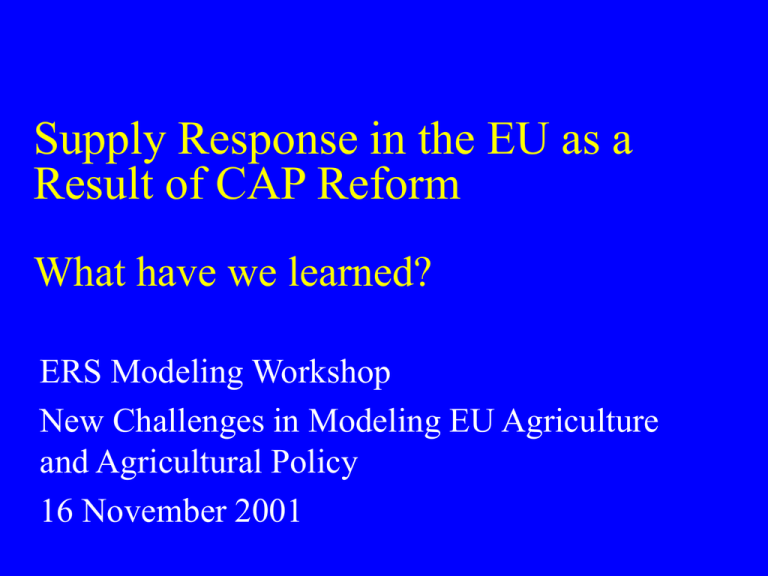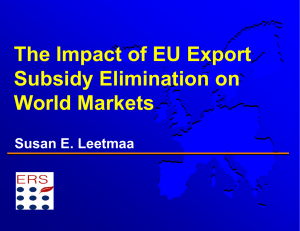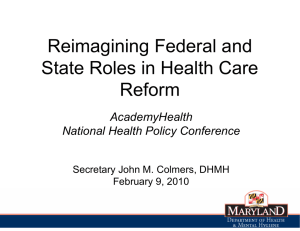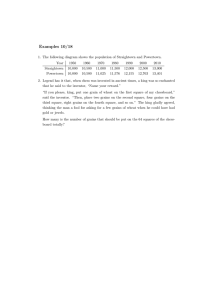Overview of Issues
advertisement

Supply Response in the EU as a Result of CAP Reform What have we learned? ERS Modeling Workshop New Challenges in Modeling EU Agriculture and Agricultural Policy 16 November 2001 Review the work we have already done. What are our future concerns? Do we need better data (i.e. elasticities) and/or better specifications for production? Should the impacts of non-price factors such as technological change have a greater role in our models? Are the impacts of blue and green box payments on production important enough that we should be thinking on how to better specify these in our models? Leetmaa, Bernstein, An Analysis of Agenda 2000, ERS-ESIM model EU grain production increases above a scenario continuing 1992 reforms due to decrease in the set-aside requirement. However, grain yields are lower than projections due to the cut in the intervention price. Growing wheat in the EU is more profitable than growing other grains, shifting some acreage out of coarse grains and oilseeds and into wheat. The reduction in EU oilseed payments would initially cause a slight shift out of oilseed production into wheat production. However, oilseed production would be slightly higher than projections due to the decreased set-aside. Production of other coarse grains (mostly rye and oats) exceed projection estimates also due to the decreased set-aside. Milk production will increase 1.2 percent a year due to the increase in the dairy quota with another 1.2 increase from 2005 to 2007. Due to lower feed costs and increases in the dairy quota and direct payments, beef production will decline only slightly, as 78 percent of EU beef is a byproduct of the dairy herd. Changes from baseline results (i.e. continuation of 1992 reforms) in 2005 Set-aside Base Agenda 2000 ERS-ESIM 17.5 10.0 FAPRI-UMC EU-SPEL 10.0 17.5 10.0 0.0 EU-CAPMAT 5.0 0.0 FAPRI 10.0 0.0 Wheat Support Price Area Production Exports -15.0 6.4 5.8 33.0 -15.0 4.0 3.3 5.4 -20.0 6.3 6.3 N/A -20.0 8.6 7.4 18.6 -20.0 12.3 8.2 37.8 Coarse grains Support Price Area Production Exports -15.0 4.5 2.5 0.0 -15.0 2.1 1.2 2.9 -20.0 6.3 5.8 N/A -20.0 3.9 2.4 -9.1 -20.0 5.2 3.2 N/A Oilseeds Area Production Exports 6.1 5.0 4.5 -2.8 -2.5 -3.1 4.0 3.2 N/A 8.9 5.6 N/A 10.3 11.1 -4.0 Beef Support Price Production Exports -20.0 -0.6 0 -20.0 -2.2 -33.6 -30.0 0.5 N/A -30.0 -0.6 -26.5 -30.0 2.8 0 Pork Production Exports 0.4 0.4 -0.5 0.7 -0.6 N/A 1.6 N/A 0.8 2.1 Poultry Production Exports 1.0 3.6 -0.5 0.6 -1.3 N/A 2.2 N/A 0.5 2.0 1/ Net exports. 2/ Net imports Supply Response Concerns with the ERS ESIM Model Do we expect any changes in yield or production elasticities as a result of CAP reform? How much of a supply response will there be (i.e. towards grains and away from oilseeds) as the intervention price falls below the world price for wheat and barley? Are there pressures for the EU to lower the set-aside rate to increase exports of wheat and barley? Beef production has always been a concern in our ESIM model-where the majority of production (78%) is essentially fixed by headage payments and other constant factors. Is this an accurate specification? Is production of poultry and pigmeat less responsive to prices as a result of the combined increase payments to beef producers and the BSE/FMD crises in the EU? How much weight should be given to so-called “other factors” (non-price, noncost factors) in our production function? Questions for Discussion What have been the main impacts of CAP reform (MacSherry or Agenda 2000) on supply/production in the EU? What reform policies have been “successfully” modeled and what policies have been more difficult to model (e.g. blue-box policies)? Have production or yield elasticities changed in our models as a result of MacSherry or Agenda 2000 reforms? Has CAP reform changed land allocation decisions in the EU? How has CAP reform changed supply response compared to other domestic or trade policies, eastward enlargement scenarios, and structural changes in EU agriculture? Can we make any predictions as to what the long-term effects of CAP reform to be on EU production? Anania, Modeling the GATT Agreement on Agriculture: Assessing the compatibility of EU Agenda 2000 with GATT commitments for wheat, CAMINIA model Uses the CAMINIA model, a mathematical programming spatial partial equilibrium model which explicitly specifies many trade policies. Runs two scenarios for each of the years 2001, 2002, and 2005-one scenario represents the continuation of MacSherry reforms and the other one represents Agenda 2000 reforms. Wheat production decreases by 0.8% between the base and Agenda 2000 reforms in 2001 (assuming a 10% set-aside). Wheat production decreases by 3.4% and 2.5% between the 2002 and 2005 base and Agenda 2000 scenarios, respectively. In the scenarios, the EU domestic price of wheat falls to such an extent that EU exports are competitive on the world market without subsidies. Weyerbrock, East-West European Integration: A General Equilibrium Analysis of Alternative Agricultural Policies, Robinsontype CGE model Runs three different scenarios-Agenda 2000, Eastern enlargement, and a combination of Agenda 2000 and enlargement. The base scenario is a continuation of 1992 reforms. In the Agenda 2000 scenarios, set-aside is set to zero. Total agricultural output shrinks in the EU by 2.3% as a result of Agenda 2000 as there is a move from rural to urban sectors. Output shrinks by 2.38% as a result of a combination of Agenda 2000 and enlargement. The largest declines occur in meat (around 6.2%), wheat (4.5-5.5%), other grains (3.9-4.6%), and oils (around 4.4%). Moro, Sckokai, Modeling the CAP Arable Crop Regime in Italy: Degree of Decoupling and Impact of Agenda 2000, Normalized quadratic profit function CAP reform tools are not neutral towards crop production. Crop-specific aids, the set-aside obligation, and related payments do affect crop supply, mainly through land allocation decisions. The impact of reform depends crucially on the differential treatment for maize. The Agenda 2000 package is biased in favor of cereal production (esp. wheat) and against oilseeds, with also a tendency towards more extensive agricultural practices. The Agenda 2000 package is far from being decoupled. In fact, the size of the production effect from the Agenda 2000 package is much larger than under the MacSherry package This study was for only for a sample of producers specializing in crop production in the North of Italy.




